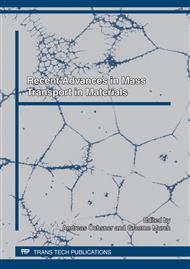[1]
K. Mimura, S.W. Lee, M. Isshiki: Journal of Alloys and Compounds Vol. 221 (1995), p.267.
Google Scholar
[2]
K.A. Lindt, A.P. Muhachev, V.V. Shatalov, M.L. Kotsar: Voprosy Atomnoy Nauky i Tehniky (VANT). «Physics of radiation damages and radiation materiology» series. №2, (1999), p.3.
Google Scholar
[3]
V.M. Ajaja, P.N. Vjugov, S.D. Lavrinenko, et al: VANT № 6, (2002), p.95.
Google Scholar
[4]
V.M. Ajaja, Vjugov P.N., Lavrinenko S.D., et al: VANT № 5, (2000), p.3.
Google Scholar
[5]
P.N. Vygov, K. C Goncharov, V.A. Kuzmenko, et al in: Multielement activation analysis with the help of (p, n) reactions. (Kharkov: HFTI AN USSR), 1987, p.10.
Google Scholar
[6]
Y. Wang, J. Jiang, Z. Zhang, X. Bian: J. Mater. Sci. Technol., Vol. 17 Suppl. 1, (2001), p.174.
Google Scholar
[7]
T. Minegishi, T. Sakurai, S. Morozumis: J. of Materials Science Vol. 26, (1991), p.5473.
Google Scholar
[8]
A.A. Vostrjakov, N.A. Vatolin, O.A. Yesin, G.F. Konovalov: Izvestiya Akademii Nauk USSR, Metals, N6, (1965), p.58.
Google Scholar
[9]
L. Ver1et: Phys. Rev., Vol. 159, № 1, (1976), p.98.
Google Scholar
[10]
X.W. Zhou, H.N.G. Wadly, R.A. Johnson et al: Acta mater., № 49, (2001), p.1005.
Google Scholar
[11]
А.К. Rappe, C.J. Cascwit, К. S. Colwe11 et al: J. Am. Chem. Soc, Vol. 114, №25, (1992), p.10024.
Google Scholar
[12]
E.A. Pastukhov, N.A. Vatolin, V.L. Lisin, V.M. Denisov, S.V. Kachin in Diffraction studies of structure of high-temperature melts. Russian Academy of Sciences, Ural Division, Institute of Metallurgy, Ekaterinburg, (2003), p.351.
DOI: 10.1023/b:rjac.0000022461.30545.2b
Google Scholar
[13]
E.A. Pastukhov, A.A. Vostrjakov, N.I. Sidorov, V.P. Chentsov: Defect and Diffusion Forum Vols. 297-301 (2010) pp.193-196.
DOI: 10.4028/www.scientific.net/ddf.297-301.193
Google Scholar
[14]
A.A. Vostriakov, N.I. Sidorov, E.A. Pastukhov, V.L. Lisin: Russian Metallurgy (Metally), Vol. (2010), № 2, p.124.
Google Scholar
[15]
A.D. Pogrjabnjak, O.P. Kulmentjeva, V.S. Kshnjakin, et al: Physica I Himiya Pererabotki Materialov №2, (2002), p.40.
Google Scholar
[16]
V.P. Kuznetsov, R.G. Loginova, M.I. Ovsjanikov, V.V. Postnikov in Process of growth and structures of monocrystal semiconductors. (Novosibirsk, Nauka, part I), 1968), p.483.
Google Scholar
[17]
R.B. McLellan, W.A. Acta Metall: Vol. 21, № 181, (1973), р. 1397.
Google Scholar
[18]
E.G. Maksimov, O.A. Pankratov: UFN, Vol. 116, issue 3, (1975), p.385.
Google Scholar
[19]
K. Mimura, S.W. Lee, M. Isshiki: Journal of Aloys and Compounds Vol. 221, (1995), p.267.
Google Scholar
[20]
W. Luo, K. Ishikawa, K. Aoki: J. Alloys and Compounds Vol. 407 (2006), p.115.
Google Scholar
[21]
S.Q. Shi, X.Q. Ma, X.N. Jing, X.H. Guo, L.Q. Chen: The 18 th International Conference on Structural Mechanics in Reactor Technology (SMIRT) (2005), August 7-12, p.186.
Google Scholar
[22]
N.L. Peterson: Diffusion in refractory Metals. Research Corporation, March (1960).
Google Scholar
[23]
J. Volkl et all: Hydrogen Diffusion in Metals in: A.S. Novik et all: Diffusion in Solids N. Y., (1975), p.232.
Google Scholar
[24]
G. Cannelli, F.M. Mazzolai: Appl. Phys. № 1, (1973), p.111.
Google Scholar
[25]
E.M. Sacris, N.A. Parlee: Metallurgical Transaction Vol. 1, December (1970), p.3377.
Google Scholar
[26]
B.A. Kolbachev, A.A. Ilyin, V.A. Lavrenko et al: Hydride system. Handbook. М. Metallurgiya, (1992), p.352.
Google Scholar
[27]
E.A. Pastukhov, A.A. Vostrjakov, N.I. Sidorov, V.P. Chentsov: Defect and Diffusion Forum Vols. 297-301, (2010), p.193.
DOI: 10.4028/www.scientific.net/ddf.297-301.193
Google Scholar
[28]
B. Roux, H. Jaffrezic, A. Chevarier et all: Phys. Rev. issue B2, (1995), p.4162.
Google Scholar
[29]
A.A. Skovorda, A.V. Spitsin: Pisma v JETF Vol. 89, issue 10, (2009), p.589.
Google Scholar
[30]
E.G. Maximov, O.A. Pankratov: Uspehi Fizicheskih Nauk: Vol. 116, issue. 3, (1975), p.385.
Google Scholar
[31]
С.P. Flynn, A. M. Stoneham: Phys Rev В1, (1970), p.3966.
Google Scholar
[32]
A.A. Shmakov, R.N. Singh: Atomic Energy Vol. 85, №3, (1998), p.675.
Google Scholar
[33]
F.V. Filipovski, I.V. Narasenko: Materials Science, Vol. 30, N3, (1994), p.368.
Google Scholar
[34]
N.N. Belash, V.R. Tatarinov, N.A. Semenov: VANT, «Physics of radiation damages and radiation materiology» series. №4, (89) (2006), p.123.
Google Scholar


